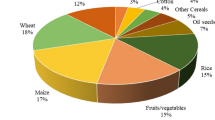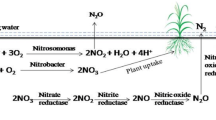Abstract
Urea deep placement (UDP) has demonstrated its benefits of saving N fertilizer and increasing nitrogen use efficiency (NUE) and grain yields. However, studies on its environmental impacts, particularly on nitrous oxide (N2O) and nitric oxide (NO), are limited. We conducted multi-location field experiments in Bangladesh to determine the effects of UDP versus broadcast prilled urea (PU) on N2O and NO emissions, NUE, and rice yields. N2O and NO emissions were measured from three N fertilizer treatments—no N, UDP, and PU—using automated gas sampling and analysis systems continuously for two rice-growing seasons—Aus (May–August) and Aman (August–December). Fertilizer-induced peaks in N2O emissions were observed after broadcast application of PU but were rarely observed after UDP. Total seasonal N2O and NO emissions, yield-scaled emissions, and fertilizer-induced emissions were affected by fertilizer treatments and sites. Though nitrogen fertilizer increased emissions significantly over the control, emissions resulting from UDP and PU were similar. Effects of N placement on grain yields and NUE were site- and season-specific. Of the N placement methods, UDP increased grain yields by 13% (p < 0.05) during the Aman season and gave similar yields in spite of lower N application during the Aus season. UDP increased N recovery from 25 and 16% of broadcast PU to 61 and 73% during the Aus and the Aman seasons, respectively in one site, but was similar in another site. On the other hand, alternate wetting and drying irrigation reduced grain yield and N recovery at the BRRI site during the Aman season.





Similar content being viewed by others
References
Adviento-Borbe MAA, Linquist B (2016) Assessing fertilizer N placement on CH4 and N2O emissions in irrigated rice systems. Geoderma 266:40–45
Akiyama H, Yagi K, Yan X (2005) Direct N2O emissions from rice paddy fields: summary of available data. Glob Biogeochem Cycles 19:GB1005. https://doi.org/10.1029/2004GB002378
Akiyama H, Yan X, Yagi K (2010) Evaluation of effectiveness of enhanced-efficiency fertilizers as mitigation options for N2O and NO emissions from agricultural soils: meta-analysis. Glob Change Biol 16:1837–1846. https://doi.org/10.1111/j.1365-2486.2009.02031.x
Bandaogo A, Bidjokazo F, Youl S, Safo E, Abaidoo R, Andrews O (2014) Effect of fertilizer deep placement with urea supergranule on nitrogen use efficiency in Sourou Valley (Burkina Faso). Nutr Cycl Agroecosyst. https://doi.org/10.1007/s10705-014-9653-6
Bronson KF, Neue HU, Abao EB, Singh U (1997) Automated chamber measurements of methane and nitrous oxide flux in a flooded rice soil: I. Residue, nitrogen, and water management. Soil Sci Soc Am J 61:981–987
Chen GX, Huang GH, Huang B, Yu KW, Wu J, Xu H (1997) Nitrous oxide and methane emissions from soil–plant systems. Nutr Cycl Agroecosyst 49:41–45
Davidson EA, Keller M, Erickson HE, Verchot LV, Veldkamp E (2000) Testing a conceptual model of soil emissions of nitrous and nitric oxides. Bioscience 50:667–680
Firestone MK, Davidson EA (1989) Microbiological basis of NO and N2O production and consumption in soil. In: Andreae MO, Schimel DS (eds) Exchange of trace gases between terrestrial ecosystems and the atmosphere. Wiley, Chichester, pp 7–21
FRG (2012) Fertilizer recommendation guide. Bangladesh Agricultural Research Council (BARC). Farmgate, Dhaka, p 1215
Gaihre YK, Singh U, Islam SMM, Huda A, Islam MR, Satter MA, Sanabria J, Islam MdR, Shah AL (2015) Impacts of urea deep placement on nitrous oxide and nitric oxide emissions from rice fields in Bangladesh. Geoderma 259–260:370–379
Gregory DI, Haefele SM, Buresh RJ, Singh U (2010) Fertilizer use, markets, and management. In: Pandey S et al (eds) Rice in the global economy: strategic research and policy issues for food security. International Rice Research Institute, Los Baños, pp 231–263
Hou A, Tsuruta H, McCreary MA, Hosen Y (2010) Effect of urea placement on the time-depth profile of NO, N2O and mineral nitrogen concentration in an Andisol during a Chinese cabbage growing season. Soil Sci Plant Nutr 56:861–869
Huda A, Gaihre YK, Islam MR, Singh U, Islam MdR, Sanabria J, Satter MA, Afroz H, Halder A, Jahiruddin M (2016) Floodwater ammonium, nitrogen use efficiency and rice yields with fertilizer deep placement and alternate wetting and drying under triple rice crop** systems. Nutr Cycl Agroecosyst. https://doi.org/10.1007/s10705-015-9758-6
IPCC (2006) National Greenhouse Gas Inventory Guidelines. Institute of Global Environmental Strategies (IGES), Kanagawa
IPCC (2014) Climate change 2014: synthesis report. In: Core Writing Team, Pachauri RK, Meyer LA (eds) Contribution of working groups I, II and III to the fifth assessment report of the intergovernmental Panel on Climate Change. IPCC, Geneva
Islam SMM, Gaihre YK, Shah AL, Singh U, Sarkar MIU, Satter MA, Sanabria J, Biswas JC (2016) Rice yields and nitrogen use efficiency with different fertilizers and water management under intensive lowland rice crop** systems in Bangladesh. Nutr Cycl Agroecosyst 106:143–156
Kapoor V, Singh U, Patil SK, Magre H, Shrivastava LK, Mishra VN, Das RO, Samadhiya VK, Sanabria J, Diamond R (2008) Rice growth, grain yield, and floodwater nutrient dynamics as affected by nutrient placement method and rate. Agron J 100:526–536
Kim DG, Hernandez-Ramirez G, Giltrap D (2013) Linear and nonlinear dependency of direct nitrous oxide emissions on fertilizer nitrogen input: a meta-analysis. Agric Ecosyst Environ 168:53–65
Lampayan RM, Rejesus RM, Singleton RR, Bouman BAM (2015) Adoption and economics of alternate wetting and drying water management for irrigated lowland rice. Field Crops Res 170:95–108
Lesschen JP, Velthof GL, Vries WD, Kros J (2011) Differentiation of nitrous oxide emission factors for agricultural soils. Environ Pollut 159:3215–3222
Liang XQ, Li H, Wang SX, Ye YS, Li YJ, Tian GM, van Kessel C, Linquist BA (2013) Nitrogen management to reduce yield-scaled global warming potential in rice. Field Crop Res 146:66–74
Linquist BA, Adviento-Borbe MA, Pittelkow CM, van Kessel C, van Groenigen KJ (2012) Fertilizer management practices and greenhouse gas emissions from rice systems: a quantitative review and analysis. Field Crop Res 135:10–21. https://doi.org/10.1016/j.fcr.2012.06.007
Miah MdAM, Gaihre YK, Hunter G, Singh U, Hossain SA (2016) Fertilizer deep placement increases rice production and economic returns in southern Bangladesh. Agron J 108:1–8. https://doi.org/10.2134/agronj2015.0170
Ravishankara AR, Daniel JS, Portmann RW (2009) Nitrous oxide (N2O): the dominant ozone-depleting substance emitted in the 21st century. Science 326:123–125
Rochette P, Angers DA, Chantigny MH, Gasser MO, MacDonald JD, Pelster DE, Bertrand N (2013) Ammonia volatilization and nitrogen retention: how deep to incorporate urea? J Environ Qual 42:1635–1642
Sander BO, Samson M, Buresh RJ (2014) Methane and nitrous oxide emissions from flooded rice fields as affected by water and straw management between rice crops. Geoderma 235–236:355–362
Savant NK, Stangel PJ (1990) Deep placement of urea supergranules in transplanted rice: principles and practices. Fert Res 25:1–83
Scheer C, Grace PR, Rowlings DW, Payero J (2012) Nitrous oxide emissions from irrigated wheat in Australia: impacts of irrigation management. Plant Soil 359:351–362
Smith P, Martino D, Cai Z, Gwary D, Janzen H, Kumar P, McCarl B, Ogle S, O’Mara F, Rice C, Scholes B, Sirotenko O (2007) Agriculture. In: Metz B, Davidson OR, Bosch PR, Dave R, Meyer LA (eds) Climate change 2007: mitigation. Contribution of working group III to the fourth assessment report of the intergovernmental Panel on Climate Change. Cambridge University Press, Cambridge and New York, pp 498–540
UNEP (2013) Drawing down N2O to protect climate and the ozone layer. A UNEP synthesis report. United Nations Environment Programme (UNEP), Nairobi, Kenya
van Kessel C, Venterea R, Six J, Adviento-Borbe MA, Linquist B, van Groenigen KJ (2013) Climate, duration, and N placement determine N2O emissions in reduced tillage systems: a meta-analysis. Glob Change Biol 19:33–44
Venterea RT, Stanenas AJ (2008) Profile analysis and modeling of reduced tillage effects on soil nitrous oxide flux. J Environ Qual 37:1360–1367
Venterea RT, Spokas KA, Baker JM (2009) Accuracy and precision analysis of chamber-based nitrous oxide gas flux estimates. Soil Sci Soc Am J 73:1087–1093
Weller S, Kraus D, Ayag KRP, Wassmann R, Alberto MCR, Butterbach-Bahl K, Kiese R (2015) Methane and nitrous oxide emissions from rice and maize production in diversified crop** systems. Nutr Cycl Agrcoecosyst 101:37–53. https://doi.org/10.1007/s10705-014-9658-1
Weller S, Janz B, Jorg L, Kraus D, Racela HSU, Wassmann R, Butterbach-Bahl K, Kiese R (2016) Greenhouse gas emissions and global warming potential of traditional and diversified tropical rice rotation systems. Glob Change Biol 22:432–448. https://doi.org/10.1111/gcb.13099
Yoh M, Toda H, Kanda K, Tsuruta H (1997) Diffusion analysis of N2O cycling in a fertilized soil. Nutr Cycl Agroecosyst 49:29–33
Zhou Z, Zheng X, **e B, Liu C, Song T, Han S, Zhu J (2010) Nitric oxide emissions from rice-wheat rotation fields in eastern China: effect of fertilization, soil water content, and crop residue. Plant Soil 336:87–98. https://doi.org/10.1007/s11104-010-0450-y
Acknowledgements
The United States Agency for International Development (USAID) provided support for this research through the project “Accelerating Agriculture Productivity Improvement-Integrating Greenhouse Gas Emissions Mitigation into the Feed the Future Bangladesh Fertilizer Deep Placement Rice Intensification (Cooperative Agreement Number AID-388-A-10-00002).”
Author information
Authors and Affiliations
Corresponding author
Rights and permissions
About this article
Cite this article
Gaihre, Y.K., Singh, U., Islam, S.M.M. et al. Nitrous oxide and nitric oxide emissions and nitrogen use efficiency as affected by nitrogen placement in lowland rice fields. Nutr Cycl Agroecosyst 110, 277–291 (2018). https://doi.org/10.1007/s10705-017-9897-z
Received:
Accepted:
Published:
Issue Date:
DOI: https://doi.org/10.1007/s10705-017-9897-z




